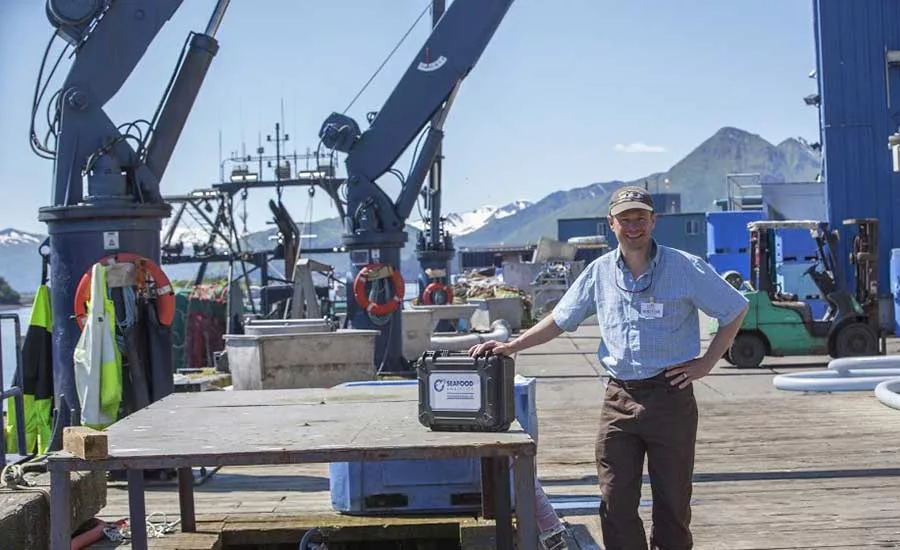Engineering R&D
Instrumentation helps provide more accurate fish quality analysis
Your senses of smell and sight may be one way to evaluate the freshness of fish, but this electronic device produces far more accurate results.


The Seafood Analytics Seafood-CQR analyzer can track quality and freshness throughout the supply chain. Source: Seafood Analytics.
“When my mom buys a fresh, never-frozen fish product, she does an organoleptic evaluation of it,” says Keith Cox, PhD, and cofounder of Seafood Analytics. “She smells it and looks for discoloration. With frozen fish products, however, you can’t do that.”
Knowing the quality of the fish before it was frozen would be great and, even better, would be tracking fresh fish from catch/harvest through every step of the supply chain. To do this, a calibrated instrument is needed.
Cox, who obtained a PhD in bioenergetics, thoroughly understood the facts about changes in body composition and muscular structure—and understood a fish out of water immediately begins a downhill slide of cellular degradation and decomposition. What was needed was a way to measure decomposition consistently and equate it to quality. He found his answer in bioelectrical impedance analysis (BIA), which uses an AC signal that is passed through the tissues of the fish.
Cox has been using BIA for the last 14 years of research on a variety of fish species from around North America and has developed an analyzer (Seafood-CQR) with technical assistance from RJL Systems. Unlike traditional bench analysis with lab instrumentation, which takes days or even weeks to get results back on protein, fat and water, the BIA-based CQR provides nearly instantaneous results. Cox has authored several papers on BIA and its use with seafood analysis. FE asked Cox to fill us in with some details.
FE: Tell us how you got into seafood quality analysis.
Keith Cox: I worked for the National Oceanic Atmospheric Administration [NOAA] as a marine biologist. My contract ended during the 2013 government shutdown, so [I] was forced to look into other opportunities. I knew that I could measure cell growth, so I figured that cell death could also be measured. After some positive-looking in-house experiments measuring cell death, we approached Oregon State University for validation of what we were considering. Simultaneously, we studied the various marketplaces that rely on knowing body composition, condition and/or freshness of organisms that are raised or farmed in aquatic environments. Seafood quality came up to the top of the list, as there is a huge gap between subjective sensory evaluations and complex laboratory chemical analysis. What was needed was a quick, easy means to measure seafood degradation and freshness that [would give] objective measurements without tedious, expensive analysis.
FE: In a nutshell, how does BIA technology work?
Cox: Organisms are comprised of cells and stuff between the cells. We measure both using electricity. When degradation happens, the cells lyse [break open], and all the fluid floods the space between the cells. So, both of the measurements would change during degradation—you are losing the number of cells and gaining the addition of fluids into the spaces between the cells.
FE: What role did RJL Systems play in the development of the analyzer?
Cox: I have worked with RJL Systems since the late 1990s, and they have been a guide, mentor and great manufacturer to work with. Their products are Class II FDA medical devices, and all are manufactured in an ISO 13485 facility in the USA. Their patented products provide the accuracy and repeatability needed to take reliable measurements on everything from humans to fish. Currently, they are our manufacturing partner and provide not only manufacturing, but also input on electrical engineering and electrical measurements. We are working together right now to develop a fish board, which will allow measurements of length, weight, GPS, impedance and temperature to be taken on fish.
FE: Early BIA analyzers got a bad rap. What has changed to make this technology viable for measuring seafood quality?
Cox: Three things: a reliable impedance device, proper measurements and validation building. The products engineered and manufactured by RJL Systems are not your grandpa’s ohmmeter that was purchased at the hardware store. They are highly complex engineering analyzers that provide accurate and repeatable measurements. Any ohmmeter can measure resistance, but to measure both resistance and reactance through skin and tissue is more difficult and requires a higher level of engineering.
As with any new technique, it is very important to develop a standard operating procedure. I saw the need to define what messes measurements up and wrote a peer-reviewed science paper to define the sources of error within impedance measurements on fish. For example, the quickest way to show that impedance does not work is to measure something on a conductive board. The electrical current is trying its best to get from point A to point B and will take the least resistance route, so if a nice conductive board is available, the current will take that pathway and not the pathway through the product. Subsequent statistics will then show that impedance did not provide reliable measurements.
Validation has occurred by engaging industry academic experts to complete studies at their universities. These engagements have given us the opportunity to show from a third-party perspective what we are doing, as well as expand into research arenas that stem from real-life industry problems.
FE: What kind of indication/output does the analyzer provide?
Cox: The analyzer measures two things and calculates the certified quality number [CQN], which gives a direct measure of degradation using a scale from 100 to 0, with 100 approximating freshly harvested. The CQN is then used to determine: (1) days since harvest, (2) shelf life remaining, (3) an FDA equivalence score and (4) if the product has been frozen. All the data can then be offloaded to the cloud, where batch information is analyzed with statistical and graphical software. The original data, statistics and graphics are available to the user.
FE: Can anyone use this and interpret the results?
Cox: Anyone can, and we can customize the screen or cloud-based dashboard to users’ needs.
FE: How does it test different species? What species to date?
Cox: The models are specific to certain fish. We have 20 different models for about 15 different species. Some of the more popular are salmon [all Pacific and Atlantic], tilapia, catfish and rockfish. We are also working on beef, pork and chicken.
FE: What is industry acceptance of this device? Is anyone using it?
Cox: Everyone thinks it is a game changer for industry, akin to first being able to take temperatures. One of the big challenges is to change how people are handling, processing and distributing fish. People have been doing things a certain way for eons, and now, there is a tool that allows price based off quality, sorting, handling practice evaluations, etc. So, early adopters are exactly that, and others usually follow them.
FE: Is it available now?
Cox: Yes.
FE: What do you see as the analyzer’s future in seafood or potentially other applications?
Cox: We are also working on two new products for seafood. One is an event monitor that will continuously measure and store quality measures on food. It is about the size of your hand and will be capable of sending data via cell or internet to the cloud. A second one is the fishboard. It is capable of measuring length, weight, GPS, temperature and impedance. All the measurements are stored electronically and, like our other products, can send the data to the cloud for further storage, statistical analysis and graphical representation.
Looking for a reprint of this article?
From high-res PDFs to custom plaques, order your copy today!





